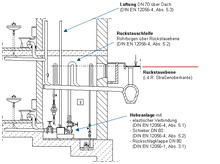Backwater (construction)
Backwater often occurs during heavy rain events or floods. When there is heavy rainfall, the water level rises above the so-called backflow level as soon as the canal system is overloaded. This describes the highest possible level of the water and is usually at the level of the road surface. If there is insufficient protection, rooms at a lower level are therefore exposed to the risk of flooding.
Technical background
For economic reasons, public canals are not designed in such a way that they can easily divert heavy rainfall in every case. Therefore, one must occasionally expect backwater in the sewers and connection lines (sewer connections to buildings). Municipalities often transfer protection against backwater to homeowners as part of their sewage statutes.
An overview of the reasons for backwater
- Flood (stream or river)
- Blockage, broken pipe, pump failure or sewer damage
- Diverting or blocking the sewer due to repair work
- Increased sewage inflow through sewer flushing, fire brigade operations or through additional / unplanned connections to the sewer network
- Heavy rain events
Structural facilities
In order to avoid damage from flooding, so-called backflow preventer (or backflow stops) are built into the pipe systems to block the wastewater and thus prevent it from entering the building. For sewage pipes that do not have a natural gradient to the sewer, so-called lifting systems or backflow lifting systems must be used, which first pump the water up through a backflow loop above the backflow level before it can flow into the sewer system.
Individual evidence
- ^ Rudolf Blasius: The city cleaning . Fischer, 1894 ( limited preview in Google Book search).
